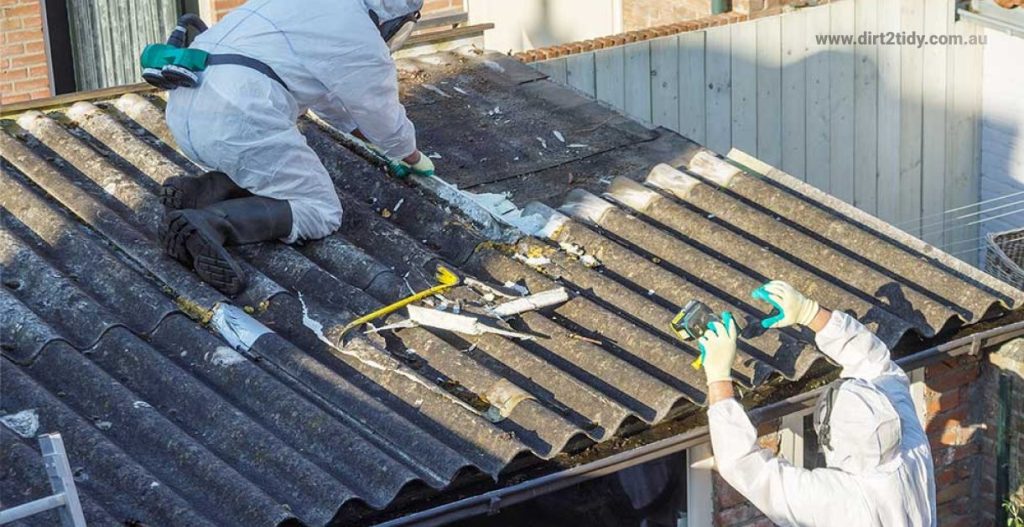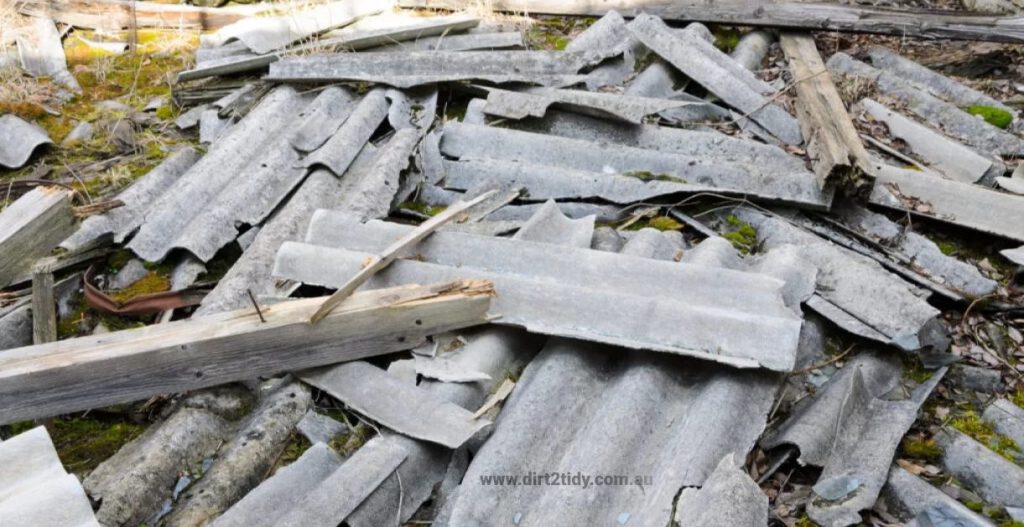After an asbestos-related action, the employer must clean and decontaminate the area before departing.
Asbestos-contaminated dust and debris must be safely collected and decontaminated (paying particular attention to walls, ledges, fittings, and furnishings).
An industrial vacuum with a HEPA filter can be utilized, but staff must be instructed in its safe usage, including how to empty and dispose of asbestos debris. Dusting with moist cloths is another option. Asbestos-contaminated clothes must be discarded.
Equipment decontamination
Before removing tools and equipment from the asbestos work area, disinfect them using a HEPA vacuum or wet rags. Solvent-based cleaning chemicals may help clean and extend the life of tools and equipment, but they must be used with proper control.
If asbestos-related instruments and equipment, like the vacuum, can’t be decontaminated in the work area, they should be:
Tag asbestos-contaminated items.
The bag must be double-bagged with a warning label (the bag must be decontaminated before being removed from area)
sealed until decontaminated or next asbestos-related action (where the equipment can be taken into the next asbestos-related activity area and re-used under controlled conditions).
When cleaning or reusing tools and equipment, use PPE.
Depending on the level of contamination, cleaning difficulties, and simplicity of replacement, it may be advisable to discard contaminated tools and equipment.
Cleansing
Before leaving the asbestos work area, workers must decontaminate. Asbestos-contaminated PPE must be double-bagged, sealed, and labeled for disposal or laundry. These methods prevent workplace contamination.
Before leaving the asbestos work area, staff should vacuum or wet wipe protective clothes and footwear to eliminate visible dust. Dust overalls using moist cloths (rubbing might damage fibers) or a fine mist. Two workers can aid each other.
Employees should remove their coveralls inside out while wearing a respirator and store them in an asbestos garbage receptacle. Respiratory protection must be worn until all contaminated coveralls and clothes are vacuumed, removed, and bagged for disposal (or laundry), and personal cleaning is completed. Employees must wash their face, hands, and fingernails after removing their respirators.

Asbestos waste
Employers must quickly control and dispose of asbestos waste.Dust in the asbestos work area contaminated clothes or PPE cloths used to clean the area contaminated items or equipment that cannot be decontaminated and are no longer needed.
Containing asbestos waste prevents airborne asbestos fibers. Before asbestos removal site decontamination Prepare:
- Damp rags
- 200-micron-thick plastic trash bags
- Before decontamination, label asbestos garbage bags. Danger: Asbestos waste.
- PPE has 200-micron plastic.
- Dust the workspace
- Clean the drop sheet with a moist wipe or towel.
- Fold rags, but don’t compress them.
- Dust your disposable coveralls, PPE, and tools using a new damp wipe or rag.
- Never reuse rags. After usage, discard.
- Drop sheets off
- Fold drop sheets so asbestos isn’t exposed.
- Wrap first-stage wet wipes or rags in the drop sheet.
- Wrap plastic sheets with duct tape and place in an asbestos garbage bag.
- PPE off
- Keep your face mask on when removing PPE.
- Discard your face mask
- Roll inside-out coveralls from the top down. Put coveralls in an asbestos bag or plastic drop sheet. Remove shoe coverings and wipe off gumboots. Throw away shoe coverings and damp wipes.
- Wipe asbestos trash bags with a moist wipe or towel (or drop sheets). Bag your used wet wipes. Label any asbestos garbage DANGER: ASBESTOS WASTE and seal it with duct tape. Soap hands, nails, and face.
Asbestos’ health effects
Breathing excessive quantities of asbestos fibres can raise the risk of:
- Mesothelioma is a malignancy of the chest and abdominal lining; asbestosis scars the lungs.
- Inhaled fibres enhance lung cancer and mesothelioma risk.
- Smoking increases asbestos-related lung cancer risk.
- Asbestosis is generally caused by long-term asbestos exposure. Symptoms emerge 20 to 30 years after first asbestos exposure.
Most persons exposed to modest levels of asbestos, as we all are, don’t get sick. When disturbed, asbestos can emit fibres that can be breathed. Long-lasting fibres increase illness risk. Asbestos that crumbles readily or has been sawed, scraped, or sanded into powder is more hazardous.

First symptoms of asbestos exposure
Early signs of asbestos-related illness often develop gradually and may not be obvious at first. Common initial symptoms can include:
- Persistent shortness of breath, especially during physical activity
- A dry, ongoing cough that doesn’t improve
- Chest tightness or discomfort
- Unexplained weight loss
- Noticeable dry, crackling sounds (often described as “rales”) when breathing in, which your doctor may detect with a stethoscope
These symptoms result from inflammation and scarring of lung tissue caused by inhaled asbestos fibers. It’s important to note that such signs can also stem from many other causes. However, if you know or suspect you have been exposed to asbestos, especially in older buildings, it’s wise to consult your healthcare provider and consider a professional inspection of your property.
Can the lungs heal after asbestos exposure?
Unfortunately, once asbestos fibres have caused damage in the lungs, such as scarring known as asbestosis, the process cannot be reversed. The body cannot heal or remove these fibres, and the damage tends to be permanent and progressive. Treatments focus on managing symptoms and improving comfort.
People diagnosed with asbestosis or other asbestos-related lung conditions are often encouraged to quit smoking, which can help slow further damage. Doctors may recommend oxygen therapy or pulmonary rehabilitation to aid breathing and enhance daily functioning. In severe situations, lung transplantation may be considered, but this option is rare and reserved for those with advanced disease.
Because asbestos-related illnesses often take decades to appear, prevention—by minimizing exposure—is very important.
Can asbestos enter the body through skin contact?
Asbestos fibres are not readily absorbed through the skin—their size prevents them from passing through. However, direct skin contact with asbestos can still cause irritation, particularly in sensitive individuals, sometimes resulting in dermatitis or redness. The primary health risk remains inhalation of airborne fibres, which is why proper personal protective equipment should always be used.
If your skin comes into contact with asbestos-containing material, promptly wash the affected area and your clothing to reduce irritation and prevent the spread of fibres. Always treat accidental contact seriously, and avoid brushing or rubbing the skin, as that may embed fibres more deeply.
When and where might asbestos be a problem?
Most modern items are asbestos-free. Few inhalable asbestos-containing items must be labelled. Many construction items and insulating components included asbestos until the 1970s. Common asbestos-containing goods and conditions include:
Steam pipes, boilers, and furnace ducts insulated with asbestos blankets or tape. Damaged, repaired, or incorrectly removed materials may emit asbestos fibres.
RESILIENT FLOOR TILES (vinyl asbestos, asphalt, and rubber), and floor tile ADHESIVES. Tile-sanding releases fibres. Scraping or sanding sheet flooring’s back may cause damage.
CEMENT SHEET, MILLBOARD, and PAPER are utilised as furnace insulation. Appliance repairs might release asbestos particles. Insulation can be chopped, torn, sanded, drilled, or sawed.
FIREPLACE, WOODSTOVE, AND COAL STOVE DOOR GASKETS. Worn seals emit asbestos fibres.
SPRAYED SOUNDPROOFING OR DECORATIVE MATERIAL. Fibres may escape from loose, crumbly, or water-damaged material. Sanding, drilling, and scraping also work.
PATCHING AND JOINT COMPOUNDS, TEXTURED PAINTS. Asbestos can be released by sanding, scraping, or drilling. Asbestos cement roofing, shingles, and siding. Unless sawed, drilled, or chopped, these products won’t release asbestos fibres.
Black Mastic Asbestos: What Is It and How Can You Spot It?
Black mastic is a type of adhesive commonly used to install vinyl floor tiles, linoleum, and even carpeting from the 1940s through the 1980s. In many older homes, especially those with original flooring, there’s a good chance this black, tar-like glue may contain asbestos fibers—particularly if your home was built before the mid-1980s.
Identifying black mastic asbestos isn’t always obvious since the adhesive often lurks beneath visible tile or flooring. Here are a few clues to help determine if you might be dealing with asbestos-containing mastic:
- Color and Texture: The adhesive is typically dark brown to black, thick, and sticky—almost tar-like.
- Age of the Home: Buildings constructed before 1985 are most likely to have used asbestos-laden mastic.
- Flooring Type: If you have original vinyl-asbestos tiles (often 9-inch squares) or older linoleum, the adhesive underneath may contain asbestos.
- Labeling: While not common, some packaging or remnants in unused spaces (like old workrooms or storage) may reference asbestos; however, lack of labeling doesn’t mean asbestos isn’t present.
Keep in mind: The only way to be certain is to have a sample professionally tested. If you suspect black mastic in your home, avoid disturbing it. As with other asbestos-containing materials, sanding, scraping, or removing it can release dangerous fibers into the air. When in doubt, call in a qualified professional—just as you would with old insulation or pipe wrappings.
Where in the home are asbestos hazards?
- Asbestos cement is used in some shingles.
- 1950 homes may contain asbestos insulation.
- Asbestos may be in textured paint and joint compound. 1977 ban.
- Gas-fired fireplace ashes and embers may contain asbestos.
- Stove-top pads may contain asbestos.
- Asbestos paper, millboard, or cement sheets can protect stove walls and floors.
- Some vinyl floor tiles, vinyl sheet flooring, and adhesives contain asbestos.
- Older homes may have asbestos-coated or asbestos-covered hot water and steam lines.
- Asbestos may insulate oil and coal furnaces and door gaskets.
Chrysotile (White Asbestos): What Is It and Where Does It Appear?
Chrysotile, more commonly known as white asbestos, was by far the most widely used form of asbestos in building products. Its flexible, fine fibers made it a favorite for manufacturers, and as a result, you’ll find it cropping up in all manner of construction materials from the early 20th century right through to the late 1970s.
White asbestos often lurks in:
- Old insulation for pipes, boilers, and ductwork
- Vinyl asbestos floor tiles and the adhesives beneath them
- Cement sheeting and siding, often spotted in mid-century homes
- Roofing shingles and corrugated roofing panels
- Certain plasters, stucco, and drywall joint compounds
- Millboard and paper used for fireproofing and insulation behind stoves and heaters
This material’s heat resistance and strength meant it sneaked into products that either needed to shield against fire or simply stand up to decades of wear. If you have a home or building dating back to before the 1980s—especially if it still has original construction materials—there’s a fair chance chrysotile could be present in hidden spots.
Remember: only a laboratory test can confirm the type of asbestos, but when it comes to suspect materials, handle them all with extreme caution.
How much does professional asbestos removal cost?
While it may be tempting to tackle asbestos concerns yourself, hiring a professional is both safer and generally recommended—especially when removal is needed rather than repair. However, this comes with a cost. On average, homeowners can expect to pay about $2,800 for professional asbestos removal, though prices typically range from $1,200 up to $3,200 depending on the extent of the work, material type, and location within the home.
Costs may fluctuate based on factors such as:
- Size of the area to be treated
- Accessibility of the asbestos-containing materials
- Level of contamination or damage
- Regional regulations and disposal requirements
In most cases, although removal is pricier than simply repairing and sealing asbestos materials, it provides greater peace of mind, especially if renovation or extensive damage is involved. Always consult certified professionals with experience in safe asbestos abatement to ensure proper handling and compliance with local health guidelines.
Is Asbestos Found in Other Insulation Materials?
When inspecting your home’s insulation, it’s common to wonder about substances like rock wool and vermiculite.
Rock wool insulation—sometimes called mineral wool—does not naturally contain asbestos. It’s manufactured from molten rock spun into fibers and is generally considered safe, provided it isn’t contaminated during installation or renovations.
Vermiculite insulation, on the other hand, can be a different story. While pure vermiculite is itself asbestos-free, much of the vermiculite sold in North America before 1990 (notably under brands like Zonolite from the Libby, Montana mines) was contaminated with asbestos. If you find loose, pebble-like insulation in your attic, do not disturb it; leave identification and sampling to professionals.
Chrysotile, also called white asbestos, was the most common asbestos variety used in construction materials. It appeared in products such as pipe wraps, floor tiles, and roofing materials—not in rock wool or vermiculite insulation by design, but cross-contamination was possible.
Always presume unknown or old insulation could be hazardous and take appropriate safety measures.
What Should Be Done About Asbestos?
Don’t worry if you suspect you have asbestos. Good asbestos should be left alone. Good-condition materials don’t emit asbestos fibres.
Check asbestos materials often. Look for rips, abrasions, or water damage without touching it. Damaged materials can emit asbestos. This is especially true if you hit, rub, or handle it regularly, or if it’s exposed to intense vibration or airflow.
When dealing with slightly damaged material, it’s better not to touch or disturb it. Toss used asbestos gloves, stovetop cushions, and ironing board covers. Consult local health, environmental, or other agencies for disposal instructions.
If asbestos is more than mildly damaged or if house improvements might disturb it, a professional must fix or remove it. Before remodeling, check for asbestos.

What materials contain asbestos?
A material’s asbestos content can’t be seen unless it’s labelled. Though in doubt, handle the material as if it contains asbestos or get it tested. A professional should analyse samples since fibres may pose a health concern. Incorrect sampling can be more dangerous than not sampling.
Not recommended: self-sampling. Taking samples yourself might discharge asbestos particles into the air or onto you. Good-condition material shouldn’t be disturbed (by renovation, for example). Sample only damaged or disturbed material. Anyone who samples asbestos-containing materials should know as much as possible about its management and follow the following procedures:
- Sample without anybody else in the room.
- Sample with gloves or wash hands.
- Turn off heating and cooling to reduce fibre spread.
- Take a little sample without disturbing the substance.
- Cover the area to be tested with plastic.
- Before taking a sample, spray the material with detergent-laced water. Water/detergent mist reduces asbestos fibre release.
- Cut a portion from the material’s depth with a knife, corer, or other sharp tool. Small portion into a clean container (for example, a 35 mm film canister, small glass or plastic vial, or high quality resealable plastic bag).
- Seal the sample container tightly
- Discard the plastic. Clean the container and sample area with a moist paper towel. State and municipal regulations govern asbestos disposal.
- Label the sample container with a number and date/location.
- Small pieces of duct tape should be used to prevent fibre escape.





